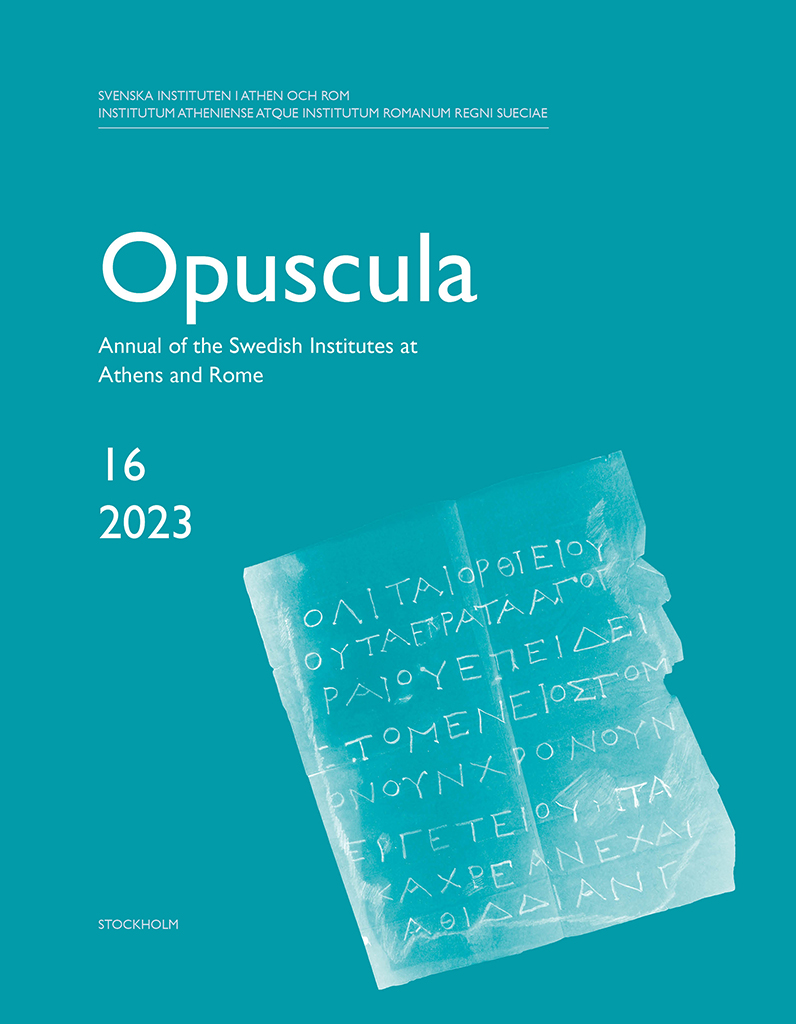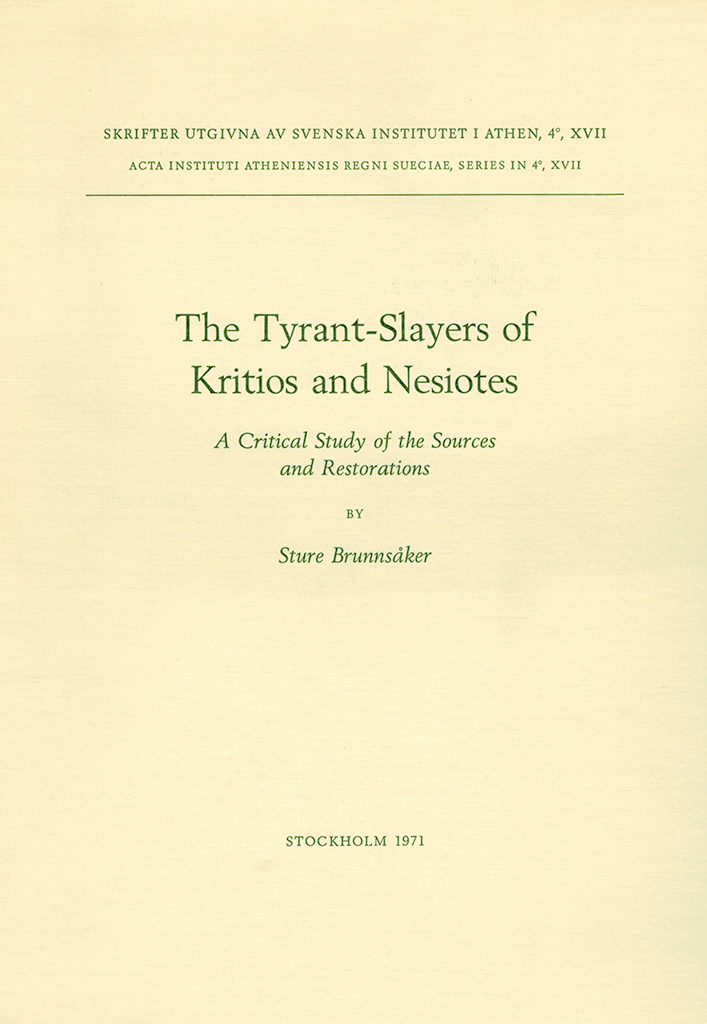Opuscula 16 is published by the Swedish Institutes at Athens and Rome. Distributed by Eddy.se AB. View volume at ERIH PLUS. All content available with open access. Johan Niklas Byström and the so-called Venus of Stockholm. New research on a presumably lost sculpture By Christian Klose Abstract The inventory books of the Skulpturensammlung (Sculpture Collection) in the Staatliche Kunstsammlungen Dresden (Dresden State Art Collections, SKD) mention a plaster cast of a Venus sculpture, moulded from the marble so-called Venus of Stockholm. In the first half of the 19th century this statue—always considered an ancient artwork—had been owned by the Swedish sculptor Johan Niklas Byström, before it was sold to an English art collector. From that time on, the sculpture has been considered lost and it has remained unregarded by research. By contextualizing the Dresden plaster cast with other ancient Venus sculptures and textual sources, this article aims to show that the Venus of Stockholm was most likely an elaborate and mirror-reversed imitation made in its entirety in the 17th or 18th century. As such, the Venus of Stockholm was exceptional, because post-antique mirror-reversed copies of ancient sculptures are very rare. In addition, the article compares the Venus of Stockholm to statues…
Opuscula 16 is published by the Swedish Institutes at Athens and Rome. Distributed by Eddy.se AB. View volume at ERIH PLUS. All content available with open access. Statuettes of pregnant sows from Knidos. New light on the cult of Demeter By Linda Talatas Abstract Four marble statuettes of pregnant swine were found in the sanctuary of Demeter at Knidos over 160 years ago, but have been largely overlooked in previous research, even though the connection between pigs and Demeter has long caught the attention of scholars, especially in relation to the piglets required for the celebration of her Eleusinian Mysteries. The statuettes raise several questions. Why make sculptures of pregnant sows? Who dedicated those offerings, and in what context? Are they related to the sacrifice of pregnant sows? And ultimately, why pregnant sows for Demeter? The article starts with a presentation of the four marble sows from the sanctuary of Demeter at Knidos, followed by a more general examination of the archaeological evidence for pig, piglet, and pregnant sow representations at Greek sanctuaries. I will then explore the epigraphical evidence for pregnant sow sacrifices, all of which is in connection with the cult of Demeter, and contextualize it with other…
Opuscula 15 is published by the Swedish Institutes at Athens and Rome. Distributed by Eddy.se AB. View volume at ERIH PLUS. Memorial sculpture in the Protestant Cemetery at Rome. New discoveries and an inventory of identified works By Nicholas Stanley-Price Abstract The funerary sculpture in the Protestant Cemetery in Rome, the heart of Catholicism, has been little studied. A new inventory of monuments lists over 130 works for which the sculptor, architect or bronze foundry, either Italian or non-Italian, has been identified. Many new identifications, often based on previously unrecorded inscriptions, have brought to light the work of well-documented foreign sculptors who had settled in Rome either temporarily or permanently. Several elaborate monuments were evidently commissions from wealthy relatives or friends of the deceased, but a greater number were contributed by artistic family members or by other fellow artists. In these frequent cases, a desire to commemorate a relative or personal friend, rather than financial gain, would have been the primary motivation. Bibliographical information Nicholas Stanley-Price, ‘Memorial sculpture in the Protestant Cemetery at Rome. New discoveries and an inventory of identified works’, Opuscula. Annual of the Swedish Institutes at Athens and Rome (OpAthRom) 15, Stockholm 2022, 189-219. ISSN: 2000-0898. ISBN:…
Opuscula 14 is published with open access. Printed edition distributed by Eddy.se AB. Also available at Amazon.com, Adlibris, and Bokus. View volume at ERIH PLUS. The Invitation to the Dance. An intertextual reassessment By Julia Habetzeder (Uppsala University, Sweden) Abstract With its original manifestation generally dated to c. 150 BC, the Invitation to the Dance is a textbook example of Hellenistic sculpture. But despite much scholarly attention there is still no consensus as to what motif the sculpture group depicts. Inspired by intertextual theory, this study catalogues and re-examines 35 sculptures of the female figure and 34 sculptures of the satyr. The article focuses on preserved sculptures, rather than a reconstructed model image. Variations of the repeated forms are highlighted as significant for the interpretation of the types. The reading of the Invitation to the Dance thus put forward suggests that the group composition displays the moment after the satyr has pulled the female’s garment down from her upper body. It is furthermore emphasized that both satyr and female figure were at times—perhaps even predominately—displayed as solitary figures. The satyr’s foot-clapper is suggested to have been included primarily in instances where the satyr was displayed on his own. Sculptures of the…
Distributed by Astrom Editions. View record at WorldCat. The Tyrant-Slayers of Kritios and Nesiotes. A critical study of the sources and restorations By Sture Brunnsåker Preface More than fifteen years have passed since this book first appeared. This edition is identical with that of 1955, except that I have been allowed to add a list of illustrations, indices, a list of corrigenda and a postscript with bibliographical addenda, dealing with the most important contributions to the discussion since 1955. Sture Brunnsåker, Uppsala, March 1971 Introduction (excerpt) Since , in 1859, Friedrichs created the basis for all further research by identifying the copies at Naples, much has been written about the statues of the Tyrant-Slayers. A variety of problems have been raised and discussed. Some have been solved, others are still under debate. Although a great number of articles and books have dealt with this monument, nobody has so far attempted to classify and examine the whole stock of evidence available to us. The main purpose of this work is to fill this gap. Since the original statues have not survived, we must base our study on the various categories of evidence, literary sources, marble copies, reproductions of the statues in…




